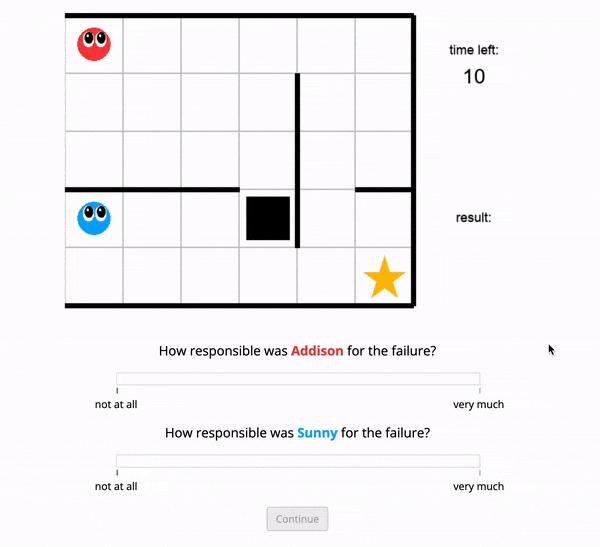A computational model of responsibility judgments from counterfactual simulations and intention inferences
This repository contains the models, experiments, data, analyses, and figures for the paper "A computational model of responsibility judgments from counterfactual simulations and intention inferences" by Sarah A. Wu, Shruti Sridhar, and Tobias Gerstenberg.
Presented at the 45th Annual Conference of the Cognitive Science Society (CogSci 2023), and published in the Conference Proceedings.
@inproceedings{wu2023responsibility,
title = {A computational model of responsibility judgments from counterfactual simulations and intention inferences},
booktitle = {Proceedings of the 45th {Annual} {Conference} of the {Cognitive} {Science} {Society}},
author = {Wu, Sarah A. and Sridhar, Shruti and Gerstenberg, Tobias},
year = {2023},
}
Contents:
How responsible someone is for an outcome depends on what causal role their actions played, and what those actions reveal about their mental states, such as their intentions. In this paper, we develop a computational account of responsibility attribution that integrates these two cognitive processes: causal attribution and mental state inference. Our model makes use of a shared generative planning algorithm assumed to approximate people's intuitive theory of mind about others' behavior. We test our model on a variety of animated social scenarios in two experiments. Experiment 1 features simple cases of helping and hindering. Experiment 2 features more complex interactions that require recursive reasoning, including cases where one agent affects another by merely signaling their intentions without physically acting on the world. Across both experiments, our model accurately captures participants' counterfactual simulations and intention inferences, and establishes that these two factors together explain responsibility judgments.
Preregistrations for all experiments are available on the Open Science Framework (OSF):
- Experiment 1 - Counterfactual, Intention, Effort, Responsibility
- Experiment 2 - Counterfactual, Intention, Responsibility, Explanation
├── analysis
├── model
├── data
│ ├── experiment1
│ │ ├─── counterfactual
│ │ ├─── intention
│ │ ├─── effort
│ │ └─── responsibility
│ └── experiment2
│ ├─── counterfactual
│ ├─── intention
│ ├─── responsibility
│ └─── explanation
├── docs
│ ├── experiment1
│ │ └─── ...
│ └── experiment2
│ └─── ...
└── figures
├── experiment1
└── experiment2
analysiscontains all the code for analyzing data and generating figures (see a rendered file here).modelcontains all the code for our environment and model (see usage details below).datacontains anonymized data from all four conditions for each experiment. For each condition,participants.csvcontains demographic information and post-experiment feedback/comments from participants, andtrials.csvcontains the response data.docscontains all the experiment code. You can preview the experiments below:- Experiment 1 - Counterfactual, Intention, Effort, Responsibility
- Experiment 2 - Counterfactual, Intention, Responsibility, Explanation
figurescontains the two figures from the paper (generated using the script inanalysis) as well as gifs and still images of all the experiment trials.
Make sure you're in the model directory and can see main.py. This is the primary file for generating trials and running the simulation models. The basic command structure for running the models on a specific trial is:
python main.py --experiment <exp> --trial <trial> --cf --intention --effort
where <exp> specifies either experiment 1 or 2, and <trial> is the trial number within that experiment, from 1 to 24. This flag can be left off to run all 24 trials of the specified experiment. The --cf, --intention, and --effort flags indicate running the counterfactual simulation, intention inference, and effort models, respectively. Any combination of these three flags can be included. For example, the command to run only the counterfactual model on all 24 trials of experiment 1 is:
python main.py --experiment 1 --cf
Other flags that can be added:
--visualizewill generate step-by-step images and a gif of the specified trial (or all trials), which will be saved intrialswithin the corresponding experiment subfolder, named by trial number.--verbosewill print out step-by-step information about each agent's plan as the trial is being generated.--n-simulations <n>specifies the number of counterfactual simulations to run, default 500.
The command --make-images can be used to generate an image of the gridworld for a given trial (or all 24 trials) in the specified experiment:
python main.py --experiment <exp> --make-images --trial <trial>
The image will be saved in the model/grid_images directory within the corresponding experiment subfolder, named by trial number. Generating these images can be helpful if you want to modify any of the current grids or create a new one and see what it looks like. All the gridworlds are located in model/grids as text files. Each file defines the grid configuration using symbols that get parsed into gridworld objects:
g--> goal squareG--> goal square with wall below.--> passable barrier between squares|--> vertical wall between squares_--> horizontal wall between squaresx--> box inside squareX--> box inside square with wall below
For example, the code below on the left implements the grid on the right:
We define the grid's origin to be the top left, and we define the following action tuples for both agents:
[1, 0]--> move right[-1, 0]--> move left[0, 1]--> move down[0, -1]--> move up[0, 0]--> stay in place
In addition, we define special action tuples for the blue agent to hold or release a directly-adjacent box:
[2, 0]and[3, 0]--> hold and release box to the right[-2, 0]and[-3, 0]--> hold and release box to the left[0, 2]and[0, 3]--> hold and release box below[0, -2]and[0, -3]--> hold and release box above
For each experiment, the trials are defined in experiments/experimentX/experimentX.json where X is the experiment number.
Each JSON string contains:
"num": the trial number (1to24)"red_start": red agent's starting location"red_path": red agent's list of action tuples (if blank, model generates it)"red_level": either0or2(always0for experiment 1)"blue_start": blue agent's starting location"blue_path": blue agent's list of action and hold/release tuples"blue_intention": eitherhelporhinder
Feel to make your own grids and trials, and test the simulation models on them!


